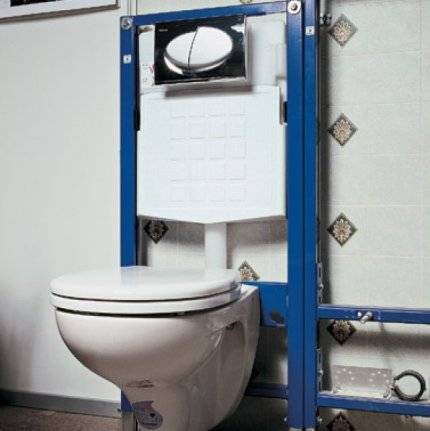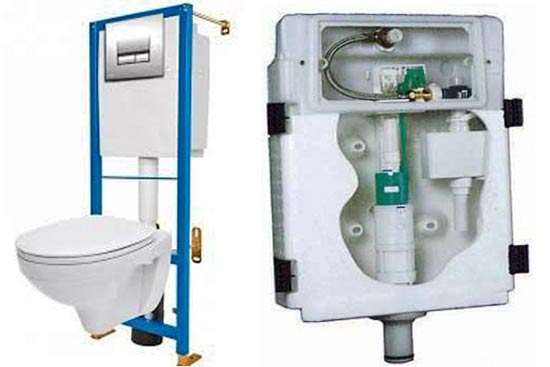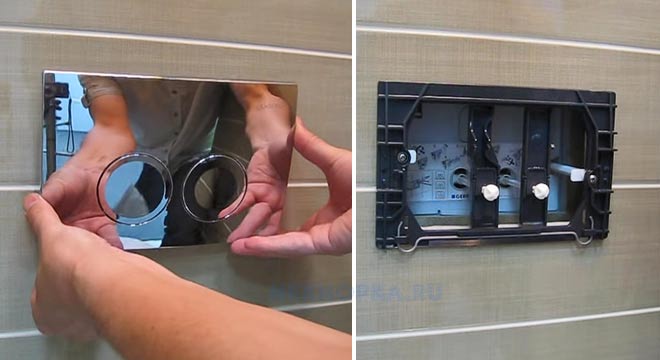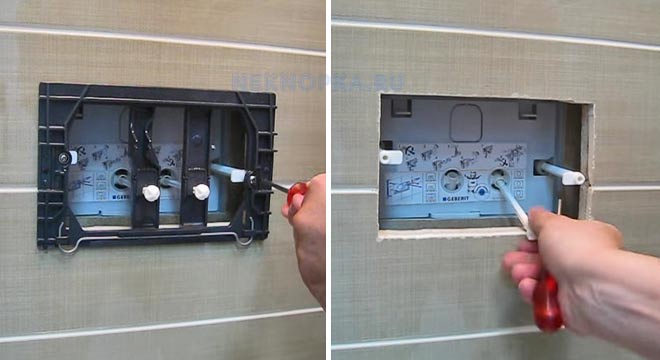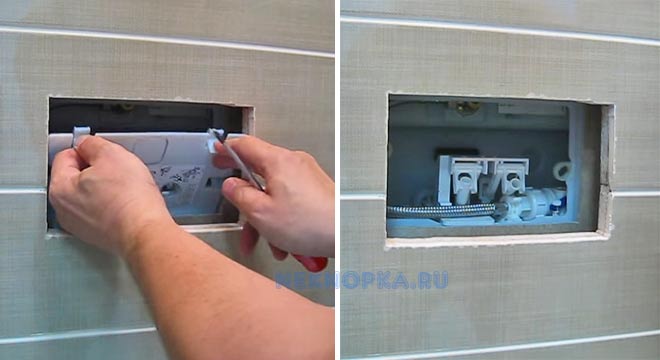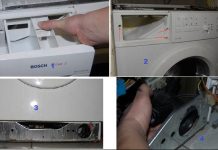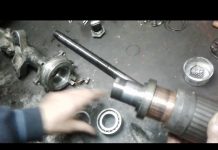The installation of block modules is somewhat different from the technology for installing frame models. General procedure for commissioning a block installation:
The main feature of plumbing repair with installation is the dismantling of the decorative box. The most common breakdowns:
When the problems are eliminated, the assembly of the toilet installation is carried out in the reverse order.
Installation for the Grohe toilet: DIY repair. Video.
VIDEO
A wall-hung toilet, like its compact brother, can also break or start leaking. This situation is not at all a sign of upcoming expensive repair work with the collapse of the walls in the bathroom - the repair of the installation for the toilet can cost a little blood.
Moreover, you can always try to eliminate the problem with your own hands, without involving a local plumber or a professional craftsman from an organization that provides such services.
A breakdown of a toilet bowl can unbalance even the most calm and good-natured person. This is not a tap that you can do without for a couple of days using a shower head. It will not be possible to live comfortably without a toilet bowl, so the issue of repairs must be resolved promptly.
Thinking that an expensive toilet installation can last forever without any problems is not worth it. Each toilet, like any other product, has its own lifespan. In some systems, it can reach 10-12 years or more.
The service life of your plumbing fixtures can be found in the manufacturer's instructions in the warranty section. If you study this document carefully, you can see that some components have a shorter life span.
Thus, the filter and gaskets must be replaced much earlier.
Built-in plumbing with an installation system consists of the following parts:
frame or frame;
cistern;
nodes for supply and drainage of working fluid;
toilet / bidet / urinal.
Breakage is possible in every part of the installation. To eliminate the cause of the malfunction, you must first find it. This task seems to be impossible without a large-scale renovation. But it seems so only at first glance.
The frame or frame is made of durable metals on the right, and the top is covered with an anti-corrosion layer. This part is durable - all other elements of the system will be attached to it. She is able to withstand up to 600-800 kg of load.
This characteristic will be different for each manufacturer. It is important to pay attention to the maximum permissible load of the model you like before buying. Sometimes, wanting to save money, they buy a cheap fake, where this figure is only 100 kg.
Such a frame can easily bend or crack from overload - about 70-80 kg the weight of an adult + a tank of water + the weight of the toilet itself. And if a large relative weighing more than 100 kg visits the bathroom, then it's scary to imagine what will happen. Therefore, you should not buy fakes - this is an unaffordable luxury.
All manufacturers make the cistern of the installation from plastic. It is flat or triangular, and inside it there is a special fitting to ensure automatic filling and flushing. What can happen to the tank:
The plastic container may break in the event of installation errors. If it was an independent installation and, due to inexperience, the installer made mistakes, the tank may warp and crack over time.
If the installation was carried out by a crooked master and accidentally hit it during installation, then after a short time a leak may occur at the place of the chip and it will be necessary to replace it with a new container.
The fittings installed inside the tank consist of plastic parts, rubber and silicone gaskets. Problems often arise due to wear and tear on one of the components.
Inlet and outlet assemblies may leak. The coarse filter installed before water enters the drain tank becomes clogged over time.And at the junctions of all the pipes, the tightness can be broken - elastic rubber gaskets fail over time, turning into hard plastic parts.
Problems can also arise with a toilet bowl - from an ordinary chip to a violation of the system for draining the working fluid into the sewer riser.
To find the source of the problem, due to which the toilet went out of working condition, you can resort to calling a plumber, call a neighbor who helps everyone and takes inexpensively, or try to do everything with your own hands.
The first option is safe, but it requires an agreement on the time of work and will cost a decent amount of money. Of course, this is the most convenient and simple option - you don't need to do anything, twist, change - he gave money and accepted a job.
The option with a neighbor / acquaintance of acquaintances is like a cat in a poke. Doubtful work quality can lead to even bigger problems and more serious breakdowns.
The third option involves an independent study of the installation system installed in your bathroom and its repair. This is a simple activity that cannot be rushed. It is important to take the manufacturer's instructions and carefully read the corresponding section. If the instruction is lost, you can find it on the websites of online stores or ask a plumbing store consultant.
All controversial moments arising in the process of repairing the installation can be viewed in thematic videos. Models of fittings for built-in cisterns from different manufacturers may differ from each other.
It is often enough to disassemble the drain tank fittings, rinse the components, replace the worn out parts, reassemble everything, and the system works like a well-oiled mechanism - without failures.
Together with the purchase of a toilet installation, it is advisable to immediately buy a spare repair kit. It may be needed after 10-12 years or after 3-4 years from the start of using the system. In order not to run around and look for spare parts, you should always have them in the closet / on the shelf with tools.
The amount of repair work will depend on what exactly broke. The most common problems associated with valves are:
Water continues to flow after the flush is complete. The reason may be accidental ingestion of foreign objects - hair, cardboard, pieces of construction waste and other inclusions - into the drain tank. The solution to the issue is to get the filling and drain mechanisms and eliminate the problem;
Water slowly comes out of the cistern after pressing the flush button. Possible breakdown of the drain mechanism lifting accordion. Exit - replace the drain mechanism;
No water is collected in the tank - there may be problems with the float. It can slide off the mount. The solution is to disassemble the system and put the float in place;
The valve does not completely shut off the water - change the membrane or replace the gasket.
It turns out that in most cases you need to look inside the cistern without getting it out of the wall. This will be done by a home craftsman, having secured instructions for dismantling the fittings.
The flush button is attached to a special frame and connected to the system using levers and cables. They are pneumatic and mechanical. It is important that the devices are reliable and of high quality for a long service life.
On sale you can see various models of buttons - backlit, with two and with one key. They differ in size, color, shape and material from which they are made. But some options can be universal - to fit the installations of different manufacturers.
If the flush button does not work well, then you need to remove it and look at the installation revision window. It is possible that the air hose supplied to the installation through the pneumatic button is not tight. Or the button itself is broken.
The solution to the issue depends on the situation - adjusting the hose or buying a new button.Often, in the instructions for a particular model, the manufacturer indicates which buttons are suitable.
When you have to find a breakdown inside the installation, it is not at all necessary to break the wall. The cistern mechanism can be reached through the inspection window. Let's take a closer look at how to do this using the example of the Geberit installation.
First you need to remove the cover plate with the flush button by pressing down and pulling it towards you. Then you have to remove the frame on which the key is attached.
To do this, unscrew the screws, pull out the plastic pusher clips. Then, in a way that depends on the model and manufacturer of plumbing, you have to remove the partition by pressing on its latches. On this partition, a diagram for dismantling the cistern fittings can be applied, which is used to clean the valves and check the gaskets.
An important step is to shut off the water entering the cistern. Otherwise, you can arrange a real catastrophe of a local scale by your actions - to flood not only your bathroom, but also your neighbors below.
Next, you should dismantle the filling valve - you must first remove the rocker arm block, and during reassembly, you have to get two rockers into the engagement of the flush valve and into 2 fixation points.
Then it was the turn of the filling valve itself, to which a flexible water supply pipe is connected. He is carefully taken out. This valve regulates the level of water filling in the tank - if you twist the plastic pin, you can raise or lower the float above or lower, which ensures that the tank is filled in the specified volume.
Now the next step is to remove the drain valve retainer - for this, the wings are spread in opposite directions, which removes the part from the cordon.
It is necessary to dismantle a rather long flush valve - one cannot do without partial dismantling inside the tank. To do this, holding the inner part, you need to unscrew the upper part and lower the second rod to the side.
That's it - the valve can be easily removed from the inner space of the cistern built into the wall. It consists of two blocks - the upper one for a small one, and the lower one for a large drain. There is a basket on the bottom of the valve, which can be easily removed if it is necessary to replace the gasket.
Now all the parts need to be carefully examined, rinsed under running water, and their condition should be assessed for wear. Replace broken parts, gaskets. After elimination of breakdowns or planned cleaning of all parts of the fittings, it is necessary to assemble all the components strictly in the reverse order.
If the state of the mechanism is extremely poor, then you need to replace the entire mechanism with a new one, using new fittings for the drain tank for this.
You can often face a situation when everything is in order with the ventilation system of the bathroom, but under the wall-hung toilet it flows and there is a disgusting sewage smell in the room, and water can flow behind the tiles inside the structure.
Here, the problem may be associated with the nodes for connecting the tank to the toilet and the toilet to the sewer.
The fact is that the basis of these troubles may be in mistakes made during the installation. It is important that the piping is correctly routed before installing the installation. Here, the length of the supply pipe and the left sewer inlet matters.
In some models of the installation, the pipes are short. This must be taken into account so that later you do not have to invent dubious schemes for sealing. The branch pipes from the installation are usually 90 mm in diameter. They are placed through an adapter into the drain, which is usually 110 mm.
When the adapter for the toilet or the installation pipe connecting the system to the sewer is short, it will be correct to buy a pipe from another manufacturer, longer. It will become perfect and everything will be hermetically sealed.
You should not save on the adapter - everything should be hermetically sealed here, there should be leaks.Some of this length is enough, while others, like the latest models, for example, Grohe, have short pipes.
It is possible to disassemble the installation without destroying the wall of the bathroom. How to do it yourself is demonstrated in the video:
VIDEO
The appearance of an unpleasant odor may be the result of an error when connecting the toilet bowl through the installation pipe to the sewer. A video clip will help to eliminate this problem:
VIDEO
When water began to appear under the wall-hung toilet, you need to find the breakdown of the installation. More details about the repair in the video clip:
VIDEO
The resulting breakdowns of the toilet installation can be eliminated by hand. This is more effective than inviting a craftsman with crooked hands, and the services of a professional plumber are cheaper. And acquaintance with the installation system may come in handy in the future, when there is a need for prompt repair.
Modern installation systems from the Swiss company Geberit are used most often. These are quality fittings that are ideal for most types of toilets. It rarely fails, and if it does, the repair of the Geberit installation is easy to carry out without breaking the wall finish. The internal system of the tank is quite suitable for replacement and adjustment. It is about troubleshooting that will be discussed in the article.
But no matter how high-quality the equipment is, it tends to fail. What contributes to this and how to repair the installation of the toilet will be discussed below. So, the types of breakdowns can be very different. Let's dwell only on the most common ones:
The tank is leaking (the reason, most often, is in the bottom valve);
The tank does not fill (the reason is a clogged filter or water supply hose);
Continuous filling of the tank (the reason is the failure of the gasket or its incorrect installation);
Malfunctions of the drain mechanism (the reason is the wrong choice of a disinfectant)
It is easy to eliminate all these and other possible malfunctions through the hole of the drain button. That is, you don't have to dismantle the partition or break the tiles. The specialist carries out a simple repair of the installation of a suspended toilet through the inspection window, because all parts of the system can be easily removed and removed.
As mentioned above, only craftsmen will perform high-quality repairs. But you can get down to business on your own, having previously studied the repair of the tank with the installation of the video, which can be viewed below. It clearly and simply tells how to dismantle the equipment, how to remove the installation button and flush the Geberi filling valve.
Procedure for dismantling the Geberit installation system:
Step one: remove the flush plate. To do this, you need to press on it from below and, thereby, carefully remove it from the cordon, and only then remove it from the wall.
Step two: remove the frame. First, the screws fixing it on the sides are unscrewed, then the pusher latches are removed and the frame is removed.
Step three: remove the septum. It is necessary to press on the special latches and remove it.
Step four: shut off the water. Without this, the repair of the cistern of the Geberite installation will turn into a flood.
Step five: dismantle the filling valve and remove the rocker arm assembly.
Step six: remove the drain valve retainer.
Step seven: dismantle the drain valve, which is located inside the tank. That's it, dismantling has been completed and repair work can be carried out.
Accordingly, the assembly of the installation after all the necessary reconstructions is carried out in the reverse order.
Having installed the installation system, after a while you can notice that water overflows through the valve and enters the tank.This is a signal that, due to harmful impurities in the water, the inlet valve of the system is clogged. There is no need to rush into panic, since all this is easy to fix on your own by watching a short video on the topic.
First, remove the valve itself. In principle, there is no need to remove it completely. It is enough to unscrew the cover and remove the rubber gasket. So it will need to be thoroughly rinsed under a strong stream of water. For reliability, we also wash the valve cover.
Now we collect everything in the reverse order and see that the malfunction has been eliminated. In such an easy way, you can independently repair the installation of a wall-hung toilet.
VIDEO
VIDEO
Repair and maintenance of the cistern mechanism video
VIDEO
Repair of the valve and membrane of the drain tank
VIDEO
VIDEO
Video review of the Geberit Delta cistern installation repair
VIDEO
Repair of faults in the Geberit cistern Leakage: disassembly, assembly
VIDEO
VIDEO
Installation of a wall-hung toilet has a lot of undeniable advantages. However, compelling practical and aesthetic priorities are occasionally overshadowed by breakdowns that need to be corrected. Agree, you shouldn't even try to restore the plumbing if you don't know how to repair the toilet installation.
We are ready to help you cope with your problem. Our proposed article describes all the ways to eliminate minor problems and serious irregularities in the operation of suspended plumbing. Valuable recommendations are given on the operation of equipment and the prevention of negative situations.
For you, we have collected and meticulously systematized all the options for breakdowns, thoroughly analyzed the methods of dealing with them using examples. The information is confirmed by a photo and video guide.
The installation system has a similar operating principle as compared to the cisterns familiar to everyone. When you press the water release lever or the button, the valve rises in the lower opening of the tank, after which the bowl is washed with water. When the tank becomes empty and the button is released, the valve returns to its original position under its own weight.
Then the automatic tank filling mechanism comes into operation. It consists of a shut-off valve that connects to the water supply. The shut-off valve works synchronously with the float.
When the tank is empty, the float goes down and opens the valve to fill the tank. Water enters the container and the float floats up in parallel. When it reaches a certain high point, the water supply is stopped and the shut-off valve is closed.
Today you can often find tanks with economical drain, where there are two buttons, one of which allows you to use any part of the tank volume.
All breakdowns can be divided into several categories, each of which is tied to a specific node of a given type of plumbing:
violation of the integrity of the drain tank;
a lot of water flows out (the bottom valve does not cope due to wear or clogging);
malfunctions in the drain mechanism (the tank does not fill or is filled continuously);
violation of the tightness when supplying water to the tank (the joints of the flexible hoses / fittings are not sufficiently sealed).
Direct repair of the toilet installation may concern even smaller elements in the structure. The main laboriousness of the work is associated with the replacement of components or the whole mechanism in the drain system.
Malfunctions can also be caused by a violation of the shape of the frame on which the installation system is located. This applies to low-cost models from dubious manufacturers or fakes. In such products, the frame is made of thin profiles, which can simply bend under the influence of the mass of the water tank.
Most of the problems in systems with installation or traditional models are associated with the appearance of malfunctions in the tank mechanism. This may be due to poor water quality, which over time corrodes metal elements and also contributes to sedimentation.
If you find that water has ceased to be correctly drawn up and drained, you may have to perform several actions.
We clean the mesh filter at the inlet to the tank (if any). It is necessary to disassemble the assembly and remove the filter to rinse and clean it with a soft toothbrush. Fractions carried by the water could clog the mesh cells.
If little water enters the tank, then it is necessary to adjust the position of the valve and float. This can be done by bending the metal lever to ensure that the float is in the correct position when filling the tank.
We make repairs to the float valve. In some cases, it could simply be skewed and needs to be aligned. In other cases, you need to check the lever that connects the float and valve. In the event of a communication failure, the valve will continuously shut off the water flow even when the float is lowered. You also need to flush the inlet valve.
After flushing, the tank starts to fill, but after the float reaches the top position, water still continues to flow into the tank. The point is most likely a clogged valve due to the fact that there are many inclusions in the water and they are deposited on surfaces.
There is no need to completely dismantle the valve - just loosen the fasteners slightly to remove the rubber gasket. It must be rinsed under a strong pressure of water, and the valve cover must also be rinsed. After that, you can make the assembly.
When you press the drain button, nothing happens. Flushing problems are associated with malfunctions in the drain fittings, in particular, with a broken connection between the valve and the button. In this case, it is best to replace the drain fittings. If you still want to pick up spare parts and make repairs yourself, we recommend that you contact your equipment supplier. A repair kit from another brand will not work.
Water in a thin stream constantly flows into the bowl. To eliminate the additional waste of water, it is necessary to replace the rubber gasket, which serves to seal the drain hole. A gap formed or a decrease in fit may cause leakage.
Occasionally, the outlet valve may deform after prolonged use. In this case, replacing the rubber gasket will not help and the entire mechanism will have to be changed.
Another reason for water leakage into the bowl can be the lowering of the emergency tube, which serves to remove excess water. It happens as follows: if the system of the inlet valve and the float breaks down, a continuous stream of water will drain directly into the toilet, preventing the bathroom or toilet from being flooded.
There are two ways to solve this problem. The first is to raise the emergency tube higher. If there is simply nowhere to raise the tube higher, then the second method will do - to lower the float below, doing it with the screws. This will slightly reduce the amount of water in the reservoir and help repair the leak.
We make repairs to the float valve. In some cases, it could simply be skewed and needs to be aligned. In other cases, you need to check the lever that connects the float and valve. In the event of a communication failure, the valve will continuously shut off the water flow even when the float is lowered.
Replacing the rubber gasket should solve most of the problems associated with poor water shutoff. Many modern models are devoid of the usual polymer gasket, having a one-piece plastic inlet valve. In this case, you will have to completely change the valve.
The degree of dismantling depends on the design. Some manufacturers produce models with an inspection window through which the drain tank can be repaired. For models of popular manufacturers, the drain button is simply dismantled, after which the master gets full access to the mechanism.
Unfortunately, not every model has such conveniences, so it is often necessary to dismantle a partition or tile. The possibility of revision must be included at the stage of installing the system with installation.
After gaining access to the tank, the following operations must be performed:
Remove the flush plate. As a rule, it just needs to be squeezed out from the back side so that it falls out of the cordon.
Remove the frame. We unscrew the screws that serve to fix the frame, and then remove the pusher clips. The frame can now be removed.
Dismantle the partition. Tighten the clamps and remove the bulkhead.
Turn off the water and press the drain button. The renovation must not be allowed to turn into a deluge.
Blot the inner surface of the tank with a rag, as it is inconvenient to work with wet parts.
Remove the valve block and disassemble the inlet valve.
Remove the drain valve retainer.
Now you can replace any components by assembling in the reverse order. Before replacing parts, you need to completely clean the installation sites from rust and sediment. To do this, you can use WD-40 and similar tools.
The toilet has to be repaired in the following cases:
cracking / chipping;
wear of the cuff, which serves to connect to the sewer;
clogging.
Damage to the bowl could appear after draining the hot liquid, as well as due to mechanical stress. If a crack appears at the bottom of the toilet bowl, you will have to completely change the bowl.
If the damage is at the top or in the place where the screws were attached, then the following set of consumables and tools will help to repair the crack:
sandpaper;
grinder;
drill with small diameter drills;
epoxy and solvent.
The edges of the crack need to be drilled out to stop further cracking. Sand the crack along its entire length and degrease the surface. The space inside the crack must be filled with resin or a similar adhesive. After that, you need to leave the toilet for a day until the adhesive composition is completely crystallized. Grind the seam the next day.
If a puddle starts to appear under the toilet, then it's time to change the cuff. This seal serves to seal the connection of the sewer pipe with the toilet bowl drain. Replacement begins with dismantling the worn out gasket. Using a knife, you need to clean the pipe surfaces from dirt. Everything should be well degreased.
Then the joint is processed with a sealant. The new collar is inserted into the drain and slipped onto the toilet flush. You can additionally take a silicone sealant from above and apply it to the contacting surfaces.
The toilet can become clogged after prolonged use. To clean hard-to-reach surfaces, you will need a plunger, plumbing cable, and chemicals.
First you need to clean the drain with a cable and a plunger. Then fall asleep "chemistry" and wait a certain time. When working with chemicals, use protective goggles, a mask and clothing that completely covers the skin. After chemical reactions, make a flush and once again process the bowl with a plunger and a cable.
Owners do not "bother" with ordinary covers, buying a new one after wear, since it is inexpensive, and the market offers models for every taste. Products with a microlift are significantly more expensive. The slow lowering mechanism could break due to a forced closing. Tightening the side mounting screws often helps to restore the microlift. If this does not help, then you need to change the entire mechanism.
The room where the wall-mounted toilet is installed takes on a special charm. It is for the sake of improving the interior that many choose systems with installation. This contributes to faster cleaning of the room, since all engineering parts are hidden behind the wall, including valves and piping.
When installing such a product, it is necessary to leave space for the revision compartment, through which it will be possible to inspect and dismantle.
The main enemy of any plumbing is water and the impurities that it carries with it. Its aggressive composition can lead to clogging and rust within a year. Therefore, it is recommended to use filters at the inlet to the tank. The presence of at least a coarse filter will significantly reduce the accumulation of dirt inside the tank, which will certainly increase its service life.
Do not forget to purchase a repair kit together with the purchase of the system. In the future, the search for compatible components may become more difficult, especially for products from foreign manufacturers, which use non-standard and unique designs of drain in the tank.
The video will help you avoid mistakes during installation and improve your understanding of the repair process.
VIDEO
Video (click to play).
The advice of experienced engineers will allow you to quickly find the cause of the malfunction in your toilet installation and quickly fix it. Study the principle of the drain system, and you yourself will be able to find the cause of the breakdown.

